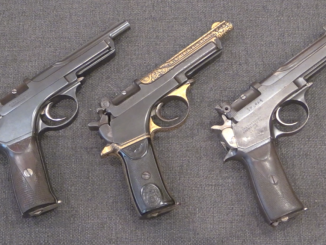Designed in the 1960s by Steyr and adopted by the Austrian Army in 1969 to replace it aging MP40s, the MPi-69 is an economical and simple 9x19mm SMG. It uses many features seen in the Uzi, including the dual sear lugs, similar barrel nut, magazine in the grip, and telescoping bolt (first used by the Czechoslovakian guns). It has a very simple square tube receiver combined with a molded polymer grip frame. The most unusual element of the design is the charging handle, which is actually operated by pulling back on the front sling attachment point.
The MPi-69 was replaced by the MPi-81 in 1981, which was essentially the same gun with a conventional charging handle. This was in turn replaced by the 9mm version of the Steyr AUG. This one is a very scarce C&R transferrable example of an MPi-69.



Is this an early prototype, conversion by a US gunsmith, or what? I’m just curious how an SMG adopted by the Austrians the year after GCA banned further MG importation for civilians got to the US beforehand.
Pulled this from Sturmgewehr…. Hope it helps. https://www.atfmachinegun.com/blog/2019/6/20/a8wocjbjjp9xzy248nqri8ussnwc6j
“(…)telescoping bolt (first used by the Czechoslovakian guns)(…)”
Whilst this might be true for widely produced one, it was predated by Armaguerra OG-43 https://modernfirearms.net/en/submachine-guns/italy-submachine-guns/armaguerra-og-43-og-44-eng/ or MCEM-2 https://modernfirearms.net/en/submachine-guns/great-britain-submachine-guns/mcem-2-eng/ both produced in prototype form only during WW2.
The Armaguerra OG 42/OG 44 bolt wasn’t telescopic, it was overhung like the Franchi LF-57 and Walther MPL. Similar principle but different construction.
The first gun to have a true telescopic bolt was a little-known Belgian pocket pistol called the Réunies Dictator, made in 1909. Probably the first SMG to employ a telescopic bolt was the MCEM-2, although this in itself may have been derived from a prewar Polish concept called the PMD (Pistolet Maszynowy Dywersyjny) which probably only existed on paper. There was also the Russian Rukavishnikov SMG developed in about 1942, though I haven’t actually seen that gun’s bolt.
No disagreement on your first point, but there’s no hard line between “telescoping bolt” and “slide”. The only real difference seems to be that guns described as having “telescoping bolts” tend to have a cover of some sort above / around them, but this is even more ambiguous now that many “slide” pistols (raceguns, chassis) have an optics bridge if not a complete top cover.
The silly thing for me was how telescoping bolt SMGs were seen as non-obvious and “innovative” to people who had grown up with slide pistols.
“(…)Armaguerra OG 42/OG 44 bolt wasn’t telescopic, it was overhung like the Franchi LF-57 and Walther MPL. Similar principle but different construction.”
Point taken. Would Beha https://www.forgottenweapons.com/submachine-guns/polish-beha-smg/ count as telescoping bolt by our standards?
“(…)MPi-69 was replaced by the MPi-81 in 1981, which was essentially the same gun with a conventional charging handle.(…)”
Interestingly despite in 1990s, MPi-81 was not new, Kovrov Mechanical Plant elected to clone older MPi-69 changing caliber to 9×18 mm. After identifying flaws this design was improved and put into production as AEK-919K https://modernfirearms.net/en/submachine-guns/russia-submachine-guns/aek-919k-kashtan-eng/
nice slow rate of fire. good bit lighter than the iconic uzi. should be very very nice subgun. though uzi has the easier safety for damn sure. but other than that… would be rather happy to be issued that.
Think I remember one from Punisher Armory back in the 90s? Cool little weapon, thanks for the video.
Before the MPi-69 there was a wide variety of submachineguns in the austrian army. Not only MP40 but also MP38, Steyr MP34, Suomis, Thompsons and M3 greese guns. A major reason behind the switch to the MPi-69 was the desire to unify the armament.
The MPi-81 was only adopted in very small numbers, mainly because the austrian army got is as an free accessory with the Steyr SK-105 “Kürassier” light tank. At this point the submachine guns of the austrian army have already been replaced by the AUG in most applications. The 9mm AUG was only adopted in very small numbers by the army as well. But it became the standard long arm of the austrian gendarmerie and police. A few years ago the police mostly replaced it with the standard 5,56mm variant because of fears of terrorists with bulletproof vests.
At some point the FN P90 was adoped in small numbers as a new SMG for the military police and the Jagdkommando and is still in use today. And at some point the Steyr TMP was adopted as well as far as I know but only in very small numbers and I’m not sure if it is still in use today.
I wonder how the first notch on the bolt does not catch the seat during firing when I release the trigger or vice versa :D. How it works that after releasing the trigger the sear catches the second notch? That is simply something I do not understand. Is it possible that the sear catches the safety notch when I release the trigger? It would be acctually cause malfunction, would not be?
thanks